Scientists are looking for ways to regenerate body tissue genes Enteropneusta
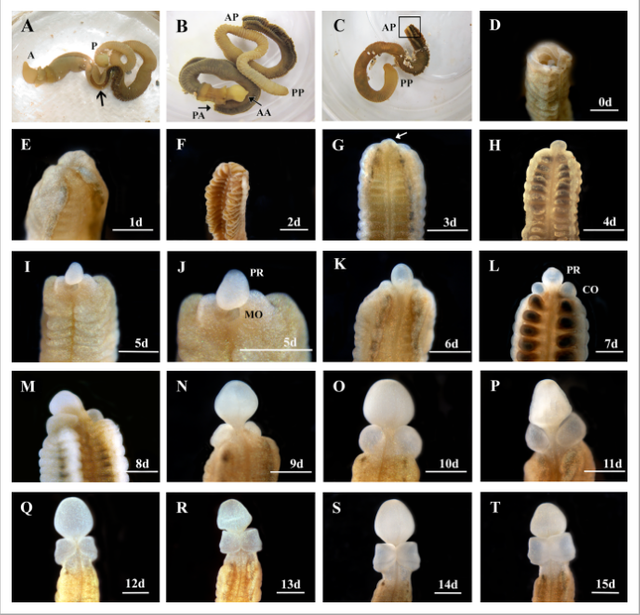
All stages of regeneration Enteropneusta worm
What would happen if people could grow amputated limbs or completely restore the function of the nervous system after spinal cord injury? A new study of invertebrates Enteropneusta revealed that one day it may become a reality.
Presumably, Enteropneusta worms are the closest relatives chordates. Some scientists believe that it came from the chord Enteropneusta and consider the past as a "missing link" between invertebrates and vertebrates. Genetic structure and the structure of the bodies of these worms are remarkably similar to human.
Research scientists from Washington University found that Enteropneusta worms can grow all the main parts of the body, including the head, the nervous system and internal organs from nothing, after they were cut in half. If scientists find the genes responsible for this mechanism so they can regrow human limbs by controlling similar genome.
"We share thousands of genes with these animals, and we have many, if not all, of the same genes that are used to restore the structure of the body. This may have implications for the regeneration of the central nervous system in the human body, if we are able to determine the mechanism that is used worms to create new organs and tissues "- said the study's lead author Shawn Luttrell.
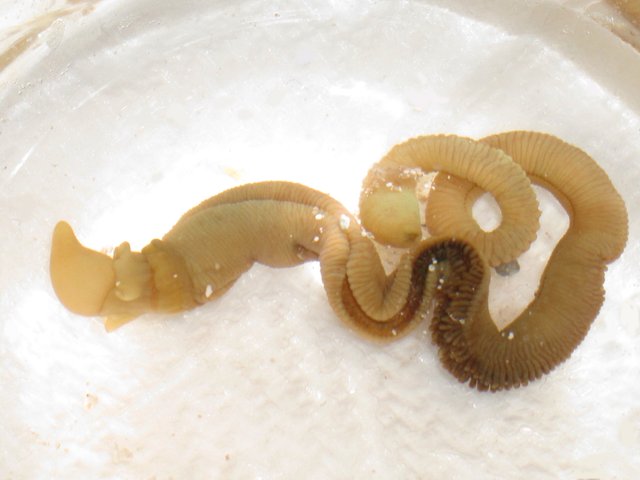
An intact body of the worm. His head is on the left side, the worm will cut down the middle.
New research has shown that when coelenterates - one of the few surviving species hemichordates - cut in half, it regenerates the head or tail on each opposite end in ideal proportions to the existing half. Imagine, if you cut a person in half, the bottom half will grow a new head and upper - leg.
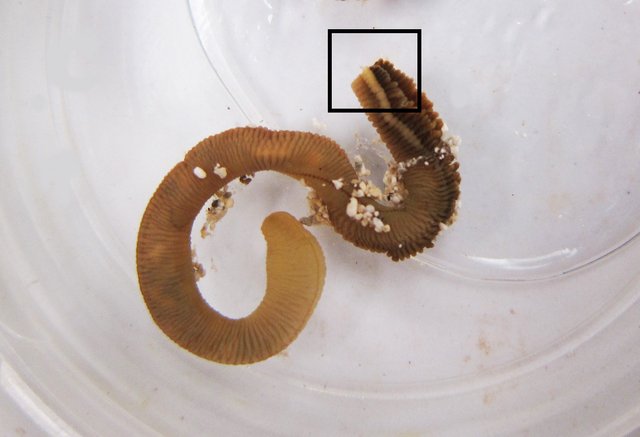
The lower half of the worm's body after cutting. The bezel marked area from which the worm will grow a new head.
After three or four days, the worms begin to grow proboscis and mouth, five to ten days spent on it to cultivate the heart and kidneys.
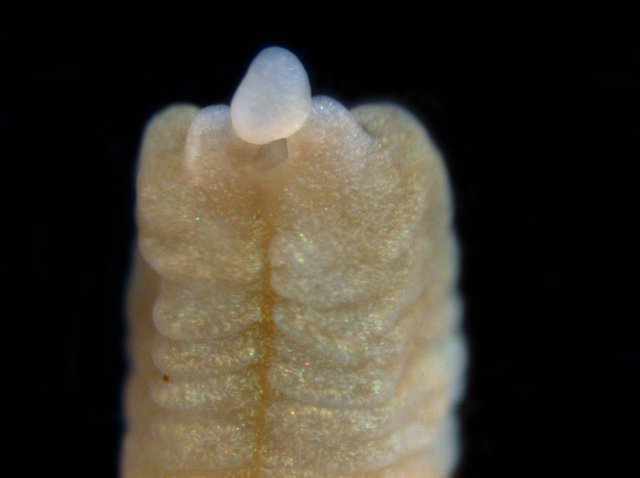
After 5 days after cutting. The slice shot closeup. Formed rudimentary head and mouth with a proboscis.
On day 15 the worms grow a quite new neural tube, which in its function corresponds to the human spinal cord. Once the worm has restored all functions of the body, it continues to the full existence and can produce healthy offspring.
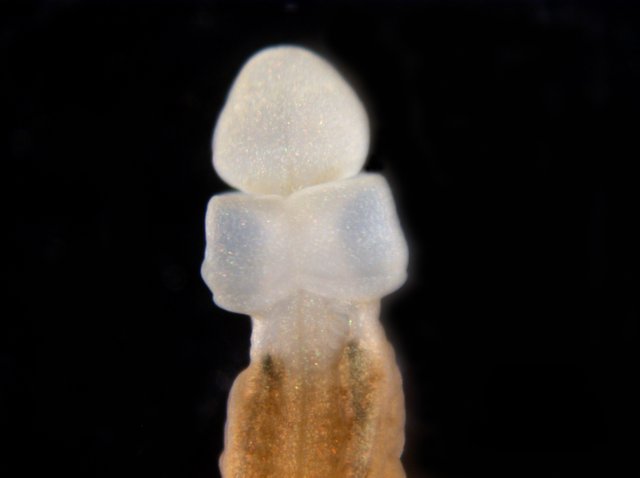
Slice close-up after 15 days. Formed more advanced head and neural tube, restores the nervous system and organ function.
Biologists team is confident that the regeneration gives individual animals and populations immortality. Their tissue is not just recovered, they again restored in the same proportions. After Enteropneusta grow a any part of the body, they can not be distinguished from those individuals who have never had to do that.
Researchers have also analyzed the expression of genes after the worms grew new body. This is the first important step for understanding the mechanisms that control regeneration. They suspect that the "remote control central regeneration" - a gene or set of genes responsible for the activation of the nature of genetic activity. The mechanism thus works like cells independently read instruction, how far the mouth should be from gill slits, and in what proportion relative to other body parts.
When the structure of these genes will be known, it will be possible to collect tissue samples of human, who suffered an amputation, and these genes in cells to activate tissue regeneration. Next, the researchers said, put the graft tissue is sufficient to cut the lost limb, and then it will grow to the desired size.
Scientists believe that humans have the capacity to regenerate, but something does not allow it to happen. Billie Swalla, director of the Friday Harbor Laboratories believes that people are the very genes that cause the fabric to recover. It is only necessary to understand how to activate them.
Regeneration is common among many species of animals. Among the vertebrates, it is most strongly developed in amphibians and fish. A person is able to restore to some extent, parts of organs, and skin cells, but it lost the ability to complete regeneration of the lost body part. Scientists suspect that there are several reasons.
Our immune system in an attempt to stop the bleeding and prevent infection may prevent regeneration, forming scar tissue on wounds. Or human too large compared with other animals too energy intensive make regeneration. Substitution limb may not be efficient in terms of energy spent on this, if we can adapt to the use of nine or ten fingers instead of one hand instead of two.
Now a team of scientists trying to figure out what type of cells used to regenerate the worms. The researchers suggest that it may be stem cells that promote tissue recovery, or other types of cells that can be redirected to the resumption of growth of the extremities. They also hope to activate genes to stimulate the complete regeneration of the animals, who now can not fully recover all the tissue.
The scientific work is published in the journal Developmental Dynamics October 25, 2016
DOI: 10.1002 / dvdy.24457
This post has been ranked within the top 50 most undervalued posts in the second half of Dec 02. We estimate that this post is undervalued by $9.42 as compared to a scenario in which every voter had an equal say.
See the full rankings and details in The Daily Tribune: Dec 02 - Part II. You can also read about some of our methodology, data analysis and technical details in our initial post.
If you are the author and would prefer not to receive these comments, simply reply "Stop" to this comment.
This is a fantastic post! Fascinating topic, I can only imagine how complicated the regulation system behind regenerative growth would be. It would be fascinating if this sort of process was possible in humans. That said, a significant amount of research is still necessary! Thank you for the great post.
As a bonus, and in addition to resteeming for exposure. We are awarding you a small 5 Steem Power deposit as a thank you for creating quality STEM related postings on Steemit. We hope you will continue to educate us all!
https://steemit.chat/channel/steemSTEM
Many thanks. Of course, I will continue.
Very interesting reading (and nice pictures)!
Thanks!
Fascinating. I had no idea about this worm. The research makes sense. How amazing would that be if they could unlock the regeneration code?
I agree. Then one would help so many people.